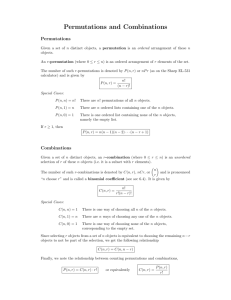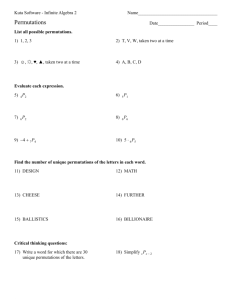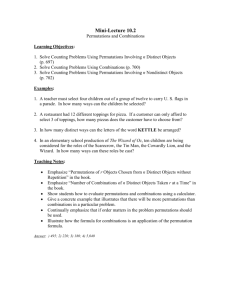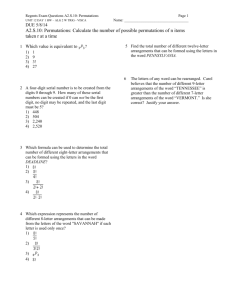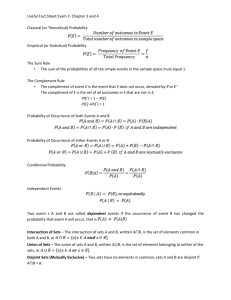Permutations
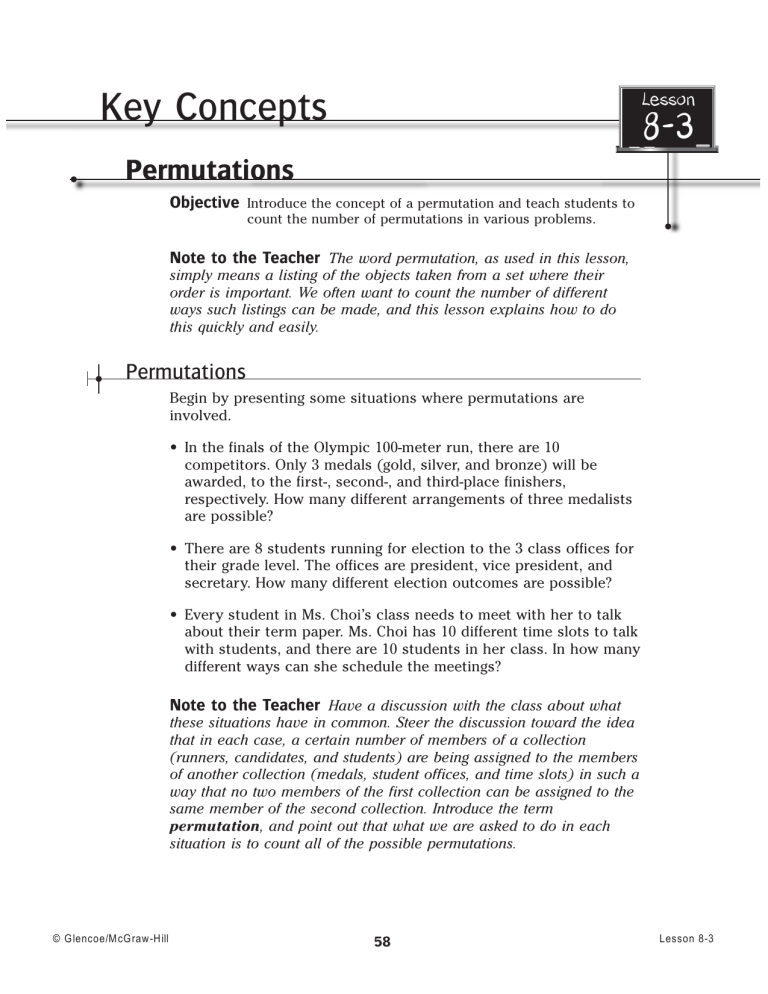
Key Concepts
Permutations
Objective
Introduce the concept of a permutation and teach students to count the number of permutations in various problems.
Lesson
8-3
Note to the Teacher
The word permutation, as used in this lesson, simply means a listing of the objects taken from a set where their order is important. We often want to count the number of different ways such listings can be made, and this lesson explains how to do this quickly and easily.
Permutations
Begin by presenting some situations where permutations are involved.
• In the finals of the Olympic 100-meter run, there are 10 competitors. Only 3 medals (gold, silver, and bronze) will be awarded, to the first-, second-, and third-place finishers, respectively. How many different arrangements of three medalists are possible?
• There are 8 students running for election to the 3 class offices for their grade level. The offices are president, vice president, and secretary. How many different election outcomes are possible?
• Every student in Ms. Choi’s class needs to meet with her to talk about their term paper. Ms. Choi has 10 different time slots to talk with students, and there are 10 students in her class. In how many different ways can she schedule the meetings?
Note to the Teacher
Have a discussion with the class about what these situations have in common. Steer the discussion toward the idea that in each case, a certain number of members of a collection
(runners, candidates, and students) are being assigned to the members of another collection (medals, student offices, and time slots) in such a way that no two members of the first collection can be assigned to the same member of the second collection. Introduce the term permutation , and point out that what we are asked to do in each situation is to count all of the possible permutations.
© Glencoe/McGraw-Hill Lesson 8-3 58
Counting Permutations
In order to show how to count permutations, let’s look at the situation involving the 10 competitors in the Olympic 100-meter run finals. This counting is done in several stages. Emphasize that for the purpose of this lesson, we assume each competitor is equally likely to win the race, even though this may not actually be true based on their past performances.
1.
First, we ask how many ways the gold medal might be won. Since there are 10 runners, there are exactly 10 possibilities for the gold medalist.
2.
Next, we ask how many ways the silver medal might be won for each gold medalist possibility we determined in Step 1. Since a runner cannot finish in both first and second place, there are only
9 runners remaining who could finish second and win the silver medal. This means that the gold and silver medals can be chosen in 10 9 or 90 different ways.
3.
Finally, we ask how many ways the bronze medal might be won for each way of choosing the gold and silver medalists. Again, a runner who has finished first or second cannot also finish in third place. So, there are now only 8 runners remaining who could finish third and claim the bronze medal. This means that there are
10 9 8 or 720 different ways for the three medals to be won.
Note to the Teacher
Spend some time on Step 2 in the problem above. Ask the class why we multiply 10 and 9 together. Lead the discussion in the direction of saying that the number of possible choices of gold and silver medalists is broken up into 10 groups (one for each possible gold medalist), and each of those groups consists of 9 possible silver medalists. So we have 10 groups of 9, which means we must multiply to count the number of two-person pairings. Here is another example to illustrate this point.
© Glencoe/McGraw-Hill 59 Lesson 8-3
Example 1
Joe, Anna, Luis, and Barbara are playing a game in which the winner receives a blue ribbon and the second-place finisher receives a red ribbon. How many possible arrangements of ribbon winners are possible for this game?
Assume each player is equally likely to win the game.
Solution Write down all the possible outcomes and then count them. There are 4 possible winners of the blue ribbon, and for each these possibilities there are
3 possible second-place finishers. A listing of all the possible outcomes is given at the right.
So there are 12 different ways for the blue and red ribbons to be won.
First Place
Joe
Joe
Joe
Anna
Anna
Anna
Luis
Luis
Luis
Barbara
Barbara
Barbara
Second Place
Anna
Luis
Barbara
Joe
Luis
Barbara
Joe
Anna
Barbara
Joe
Anna
Luis
Note to the Teacher
Point out to students that the list in Example 1 can be viewed as showing 4 groups, one group for each possible first-place winner having each of the other three players as the second-place finisher. Copy the outcomes on the chalkboard, and circle each of the four groups.
General Method
In general, when we are given a problem involving permutations, where we are choosing r members from a set with n members and the order is important, the number of permutations is given by the expression
Key Idea
n ( n 1) ( n 2)
…
( n r 2) ( n r 1).
The first factor indicates we can choose the first member in n ways, the second factor indicates we can choose the second member in n 1 ways once the first member has been chosen, and so on.
Conclude the lesson by presenting several examples where the number of permutations is calculated for a given situation. The following two examples refer to the situations presented at the beginning of this lesson.
© Glencoe/McGraw-Hill 60 Lesson 8-3
Example 2
Refer students to the situation at the beginning of the lesson involving the scheduling of Ms Choi’s student meetings. In how many different ways can she schedule the meetings with her 10 students if she chooses their names at random?
Solution There are 10 ways to choose a student for the first time slot, then 9 remaining students from which to fill the second time slot, and so on until there is only one student remaining to be assigned to the final time slot. So there are
10 9 8 7 6 5 4 3 2 1 or 3,628,800 different ways to fill the 10 time slots.
Example 3
Refer students to the situation at the beginning of the lesson where 8 students are running for the 3 class offices, president, vice president, and secretary. Suppose the student who receives the most votes is named class president, the second-place finisher is named class vice president, and the third-place finisher is named class secretary. How many different 3-person groupings of class officers are possible? Assume each candidate is equally likely to be elected to each office.
Solution There are 8 possibilities for the class president, then
7 remaining possibilities for the class vice president, and finally 6 remaining possibilities for the class secretary. So there are 8 7 6 or 336 different 3-person groupings of class officers.
© Glencoe/McGraw-Hill 61
End of
Lesson
Lesson 8-3




